| Pages:
1
2
3
4
..
7 |
Fossil
Hazard to Others
  
Posts: 131
Registered: 4-4-2012
Location: Canada
Member Is Offline
Mood: No Mood
|
|
Sorry, i thought you guys stopped talking about cheddite, and yes, i do know the difference between a deflagration and a detonation.
And yes, perchlorate is used in flash powder compositions because it is much more stable than compositions made with a chlorate mixture.
|
|
|
caterpillar
Hazard to Others
  
Posts: 472
Registered: 8-1-2012
Member Is Offline
Mood: No Mood
|
|
Quote: Originally posted by Fossil  | Sorry, i thought you guys stopped talking about cheddite, and yes, i do know the difference between a deflagration and a detonation.
And yes, perchlorate is used in flash powder compositions because it is much more stable than compositions made with a chlorate mixture.
|
Perchlorates have better oxygen balance too. One way to prepare KClO4 is to melt KClO3. I suspect that this op is potentially dangerous one.
Women are more perilous sometimes, than any hi explosive.
|
|
|
Vikascoder
Hazard to Others
  
Posts: 309
Registered: 28-1-2012
Member Is Offline
Mood: No Mood
|
|
most easy way of making potassium perchlorate from potassium chlorate is to just add hydrogen peroxide. this will give one mmore oxygen atom to
potassium chlorate molecule forming potassium perchlorate
|
|
|
Bot0nist
International Hazard
    
Posts: 1559
Registered: 15-2-2011
Location: Right behind you.
Member Is Offline
Mood: Streching my cotyledons.
|
|
Quote: Originally posted by Vikascoder  | | most easy way of making potassium perchlorate from potassium chlorate is to just add hydrogen peroxide. this will give one mmore oxygen atom to
potassium chlorate molecule forming potassium perchlorate |
Says who? They lied to you. That is a silly assumption that a non chemist would make.
With all due respect Vik, that is total BS. If that was so, people wouldn't bother with thermal dissappropriation or electrolysis. This lie has been
shot down on SciMad many times. Please do not regurgitate misconceptions.
Also, if the production of perchlorates is your interest, please continue in the many perchlorate threads. Don't further derail this one, which has
nothing to do with perchlorate manufacturing.
Thanks.
Quote: Originally posted by woelen  | That video is crap. Chlorate does NOT react with peroxide to make perchlorate!
Making perchlorte from chlorate cannot be done with MMO anodes, but it can be done with PbO2 anodes or platinum anodes. Another (more dangerous)
option is to carefully heat perfectly pure KClO3 in a perfectly clean heat resistant glass apparatus until it just melts and then keep the temperature
constant. Slowly the chlorate is converted to perchlorate and chloride. This latter procedure was used in the past as the main method for making
perchlorate, but nowadays it is replaced by electrolysis with PbO2 or platinum anodes, because of safety concerns. |
[Edited on 16-4-2012 by Bot0nist]
U.T.F.S.E. and learn the joys of autodidacticism!
Don't judge each day only by the harvest you reap, but also by the seeds you sow.
|
|
|
weiming1998
National Hazard
   
Posts: 616
Registered: 13-1-2012
Location: Western Australia
Member Is Offline
Mood: Amphoteric
|
|
Quote: Originally posted by Vikascoder  | | most easy way of making potassium perchlorate from potassium chlorate is to just add hydrogen peroxide. this will give one mmore oxygen atom to
potassium chlorate molecule forming potassium perchlorate |
There has been discussions about the oxidation of KClO3 to KClO4 on this very forum. Example: http://www.sciencemadness.org/talk/viewthread.php?tid=16931
On that thread, it says that H2O2 will not work in oxidizing KClO3 to KClO4. It is not a strong enough oxidant. But elemental fluorine, ozone and
ferrates will work though, with the last option being the least dangerous.
[Edited on 16-4-2012 by weiming1998]
|
|
|
Vikascoder
Hazard to Others
  
Posts: 309
Registered: 28-1-2012
Member Is Offline
Mood: No Mood
|
|
thanks Bot0nist and weiming 1998 for correcting me . i was also thinking that this process doesnt seem to work but according to this video i got the
information
http://www.youtube.com/watch?v=9YVsEX-ikUQ
and i told you what it was told in this video .thanks once again for correcting me .i havent tried it myself i hope i have not irritated you. and i
am not interested in making potassium perchlorate.
please forgive me for my wrong information
|
|
|
Hennig Brand
International Hazard
    
Posts: 1284
Registered: 7-6-2009
Member Is Offline
Mood: No Mood
|
|
I have never detonated a cheddite, but I plan to do some experimenting soon. I have read that MNT and DNT will both work well. I have some pdfs of
some old books with procedures for preparing some cheddites. IIRC, from reading the cheddites that use nitroaromatics are much easier to initiate than
the cheddites that just use fuels/hydrocarbons. They are also more powerful of course.
I am going to try MNT and DNT with KClO3. Should I try nitro-naphthalene next, or a different nitroaromatic?
This was from an old book (early 1900's). I kept this section as a word document, sorry I don't seem to have the reference.
"Chlorate and Perchlorate Explosives.
The developments of electro-chemistry having resulted in the production of
chlorates in large quantity, an outlet for these was sought in the sphere of
explosives and ultimately found. Chlorates have long been forbidden lor
explosives manufacture on account of the sensitiveness of mixtures containing them
to shock and friction. Street found, however, that by using castor oil in the mixture
this danger was obviated (D.R. Patent 100,522, 1897; 100,532, 1897; 117,051,
1898; 118,102, 1898). Cheddites, so-called from their place of manufacture,
Chedde, in Haute-Savoie, are composed as follows (Dr Escales' article on
" Explosivstoffe," Dammer's "Chemische Technologie der Neuzeit"): (1) KC1O3
79 per cent., nitro-naphthalene 15 per cent., castor oil 6 per cent. ; (2) KO08
79 per cent, dinitro-toluene 15 per cent, nitro-naphthalene 1 per cent, castor oil
5 per cent; (3) NaC10s 75 per cent., dinitro-toluene 19 per cent, nitro-naphthalene
1 per cent, castor oil 5 per cent.; (4) KC103 80 per cent., dinitro-toiuene 2 per
cent., nitro-naphthalene 10 per cent., castor oil 8 per cent.
Manufacture
The dinitro-toluene and nitro-naphthalene are dissolved in warm (6o°-7o°) castor
oil contained in a double-walled enamelled iron vessel, and the finely pulverised,
dried and sieved potassium chlorate is added with constant stirring or kneading by
means of a large wooden paddle. After further working the explosive is corned
and on standing for some time is made into cartridges which are waterproofed."
I have more material on cheddites too, if I can find it.
[Edited on 22-4-2012 by Hennig Brand]
|
|
|
quicksilver
International Hazard
    
Posts: 1820
Registered: 7-9-2005
Location: Inches from the keyboard....
Member Is Offline
Mood: ~-=SWINGS=-~
|
|
CHEDDITE is still a commercial company. They may be publicly traded in Europe's various sock exchanges. They make a great deal of firearm's related
energetics.
|
|
|
Hennig Brand
International Hazard
    
Posts: 1284
Registered: 7-6-2009
Member Is Offline
Mood: No Mood
|
|
Yes, if you search for cheddite now you are more often than not going to get hits for shot gun primers and things, very annoying if you want the old
fashioned main explosive charge type.
Here is a little more specific information on Cheddites:
Taken from the chapter on Potassium Chlorate, in the text Military Pyrotechnics Vol 1 by Faber, Henry Burnell
The following jpg is of the table which preceeds the text below.
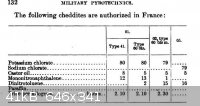
"In making cheddite mixtures, the nitro compounds are
first dissolved in the castor oil at 80° C, and the finely pow-
dered, dry, warm chlorate is then added gradually, while the
mass is stirred with a wooden rod. The incorporation of a
charge of 25 kilograms lasts about 10 minutes. The mate-
rial is then carried to another building where it is further
mixed on a wooden board while half -cold for another 10 min-
utes, so as to get it in a suitable granular condition. Each
particle of chlorate should be entirely coated with the oily
mixture. The material is next sifted and what is too fine is
added to a later charge. That which is of the corect size is
made into cartridges by ramming it into wooden molds, from
which it is transferred to paper cases. If the explosive con-
tains sodium chlorate, the cases should be then dipped in
molten parafiin to prevent the absorption of water : If the
per cent, of moisture rises above 1 per cent, the explosive is
impaired.
Cheddite is a soft yellowish material of fine grain, but is
sometimes artificially colored. In consequence of its plastici-
ty, it can easily be compressed. It is generally put up into
cartridges 22 cm. long and 2.5 cm. diameter. Cheddite
(41) is a slow, mild explosive, which splits rocks rather than
shatters them. Cheddite (60) is more violent, and the so-
dium-chlorate cheddite (05), still more so. The velocity of
detonation of cheddite (60) was measured by Llieure
and found to be 3,175 meters per second, about half that of
picric acid, and blasting gelatine and other very high explo-
sives, and that of (02), 2,750 meters per second."
[Edited on 24-4-2012 by Hennig Brand]
|
|
|
Farnsworth
Harmless

Posts: 37
Registered: 11-5-2012
Member Is Offline
Mood: No Mood
|
|
Point of curiosity related to this thread.
In the older text cited above concerning the substitution of KMNO4 for chlorates in a cheddite mixture brought to mind an older topic concerning
sodium chlorate combined with liquid fuels and water for achieving unusually high detonation velocities. See:
http://www.sciencemadness.org/talk/viewthread.php?tid=4076
I know KMNO4 is bad news when combined with most of the common fuels discussed in that thread. Everyone knows what happens with glycerine and
according to the MSDS it becomes a dangerously spontaneous explosive when combined with diethylene glycol. Are there any suitable liquid fuels with
which it can be combined without becoming dangerously unstable / self decomposing? Ethyl alcohols seem to be out due to reactivity which would have
been a very convenient package. MSDS pegs it as highly soluable in methanol but also notes that it's incompatible with alcohols in general. Can
someone with a better understanding of its full spectrum of reactivity chime in?
Edited for details.
[Edited on 19-5-2012 by Farnsworth]
|
|
|
Vikascoder
Hazard to Others
  
Posts: 309
Registered: 28-1-2012
Member Is Offline
Mood: No Mood
|
|
One more cheddite compositon i found . As i failed in making picric acid yesterday by mistake i made dinitrophenol instead of trinitrophenol. I mixed
2 grams of dinitrophenol with 3 grams of potassium chlorate and detonated it with HMTD and a no 8 blasting cap it was really very loud bang.
|
|
|
Hennig Brand
International Hazard
    
Posts: 1284
Registered: 7-6-2009
Member Is Offline
Mood: No Mood
|
|
There is a good section in the COPAE on Cheddites. I have included a snip-it from the text.
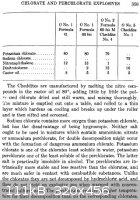
"A risk-free world is a very dull world, one from which we are apt to learn little of consequence." -Geerat Vermeij
|
|
|
niertap
Hazard to Self
 
Posts: 76
Registered: 5-8-2011
Member Is Offline
Mood: hyper-conjucated
|
|
Potassium Dichromate supposedly catalyzes perchlorate decomposition. I've seen multiple references to it in pyrotechnic star primes, though never a
scientific source.
However i'm unsure if it would also apply to the reaction conditions of detonation. Also cancer.
I've only had luck with chlorate cheddite when it's bound with some nitrocellulose and has a little MnO2 in it. Though this was without a booster and
just a little AgN3.
Ignorance is bliss
Outliers in life are modeled by chemical kinetics
|
|
|
al93535
Harmless

Posts: 13
Registered: 22-5-2004
Member Is Offline
Mood: good
|
|
Dichromate absolutely does catalyze the decomposition of KClo4. While trying to make stars at work safer to manufacture, I removed the 5% dichromate.
In a mine those stars burned so much slower, they almost came back to the ground. So there is a significant effect that the dichromate has upon the
stars burning speed.
You do bring up a good point about if the dichromate will assist in a KClo4 detonation.
I would like to try making a cheddite but replace the KClo3 with KClo4. Now i am considering adding 3% milled Potassium Dichromate to the mix.
I am considering this:
KClo4 70
DNT 17
Dichromate 3
Vaseline 10
However there is not very much information on perchlorate explosives, I have found my only reference in COPAE.
I have made regular cheddite with 90% KCl03 and 10% vaseline. It was easily detonated with a commercial No. 8 cap. I have a video of it, If I can
put a link here to it??
|
|
|
Hennig Brand
International Hazard
    
Posts: 1284
Registered: 7-6-2009
Member Is Offline
Mood: No Mood
|
|
I finally got away from the city for a little bit and took a break from eating Christmas cookies and turkey to do a little experimenting. Had some
impure KClO3, with a little graphite mixed in from carbon electrode errosion, and some TNT heavily contaminated with DNT (~76% TNT / 24% DNT). I have
always put off making a Cheddite, but decided that today was the day. A nifty little pull igniter was used, which was activated from 100 feet away or
so by the pull of a string, in order to initiate the firing train.
In general the instructions from COPAE were used for preparing the Cheddite. Water was boiled in a kettle and then put into a saucepan which was used
as a hot water bath. A 600 mL beaker was used to mix the components together and was held in the hot water bath to keep the mixture at around 80 C.
The TNT-DNT mixture was dissolved in the castor oil first then the powdered KClO3 was added, by the spoonful, and the mixture stirred well with a
piece of small diameter wooden dowel. Once the mixture was considered homogeneous it was dumped out onto a table, on a big piece of waxed paper, where
it was flattened out with the back of a plastic spoon and allowed to cool before being broken up with the same spoon.
Quantities used:
84 g KClO3
16 g TNT/DNT
5.5 g Castor Oil
I pressed half of what was made (~ 53 g) into a plastic pill bottle of about 40 mL in volume, which gave an overall charge density of about 1.32 g/mL.
I was not, however, nearly careful enough to get the density uniform throughout the charge. The blasting cap was made with about 0.6 g PETN as base
charge, 0.3 g lead azide as primary and a little basic lead picrate as flash igniter. Visco fuse (1/8") was used. The end of the fuse which was to be
placed directly beside the percussion cap was dipped in NC lacquer and covered in black powder (fast burning powder/dust from the ball mill) before
being allowed to dry several hours before use. A little gun cotton was also stuffed in around the base of the primer, but was probably not needed.
About 100 feet of thin nylon cord was used to pull the pin. The firing train worked perfectly, even where the fuse had been cut and 4 matches put in
place where it had been taped back together. The charge however was only a partial success. There was a definite detonation, but the ground below the
charge was littered with undetonated material. It seems from looking at the aftermath that the material next to the detonator went off, but the
material much below did not.
A few pictures:
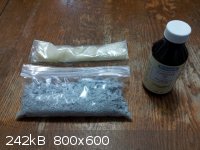 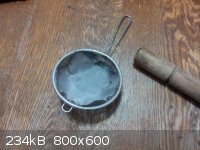 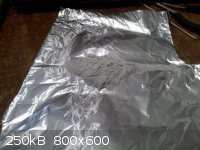 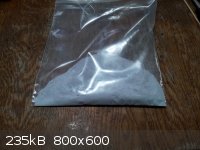 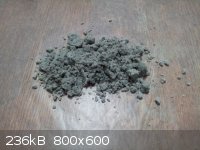 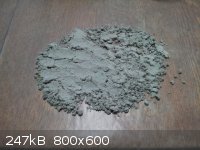
[Edited on 27-12-2013 by Hennig Brand]
"A risk-free world is a very dull world, one from which we are apt to learn little of consequence." -Geerat Vermeij
|
|
|
Hennig Brand
International Hazard
    
Posts: 1284
Registered: 7-6-2009
Member Is Offline
Mood: No Mood
|
|
A little KMnO4, or a couple percent of NG, might make a big difference in the ease with which this mixture is initiated.
The charge and initiating system where not put together for aesthetic appeal, but more to test some concepts, as can be seen by the clumsy looking
system. BTW, the KClO3 was powdered using ~ 100 mesh SS screen (from a fuel screen) epoxied into a small kitchen strainer and a wooden rod with a
rounded end. If doing large quantities a ball mill or some other automated milling machine would be very advantageous.
As you can see the little piece of maple that the charge was attached to was blown to splinters. even though there was only a partial detonation. The
biggest piece of the maple stick found was located 6-8 feet away after detonation, and can be seen in the pictures below.
The partial detonation could have been prevented. A strong detonator was used, but charge density was not carefully controlled (even though overall
charge density was in the correct range) and there was very weak confinement.
A few more pictures:
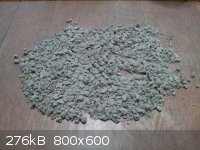 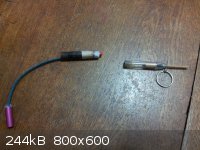 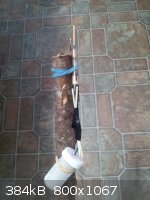 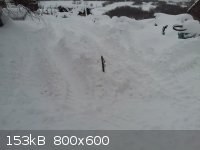 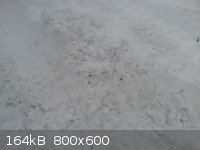 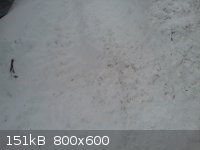
[Edited on 27-12-2013 by Hennig Brand]
"A risk-free world is a very dull world, one from which we are apt to learn little of consequence." -Geerat Vermeij
|
|
|
Turner
Hazard to Others
  
Posts: 197
Registered: 2-12-2013
Member Is Offline
Mood: No Mood
|
|
Cool why such a way to light the fuse?
|
|
|
Hennig Brand
International Hazard
    
Posts: 1284
Registered: 7-6-2009
Member Is Offline
Mood: No Mood
|
|
Thanks, it was just a test, but really it is a much safer way to light the fuse. Even with good fuse, bending over a charge lighting a fuse with a
lighter or match is taking a risk. Pulling the cord from 100 feet away is very low risk in comparison. The simple design above uses a compression
spring, but most grenades etc use a torsion spring which makes them much more compact. I saw a few youtube videos, and then made a few modifications
of my own.
[Edited on 27-12-2013 by Hennig Brand]
"A risk-free world is a very dull world, one from which we are apt to learn little of consequence." -Geerat Vermeij
|
|
|
Pard
Harmless

Posts: 38
Registered: 29-11-2013
Member Is Offline
Mood: No Mood
|
|
Is that a cap gun cap there? I take it that it sets of your detonators charge.
|
|
|
Hennig Brand
International Hazard
    
Posts: 1284
Registered: 7-6-2009
Member Is Offline
Mood: No Mood
|
|
Yes, with a suitable firing train they can reliably light visco or cannon fuse (or whatever).
"A risk-free world is a very dull world, one from which we are apt to learn little of consequence." -Geerat Vermeij
|
|
|
Zyklon-A
International Hazard
    
Posts: 1547
Registered: 26-11-2013
Member Is Offline
Mood: Fluorine radical
|
|
Here, I found something that says you can make a 'cheddite' with KNO3, I don't trust this site at all, but I tried it anyway, it says ''When wet
it is harmless... but when it dries it is
highly explosive and shock sensitive. ****store in oil''.
''Well this is stupid'', I thought, petroleum jelly never will dry, anyway, it didn't work at all, I followed the instructions exactly, and just for
fun I set it out to 'dry', now 2 months later it looks the same, not going to work at all, ever.
I suggest that you don't try anything from this site, about half of the things they say are false, and the other half can get you killed.
[Edited on 30-12-2013 by Zyklonb]
|
|
|
Turner
Hazard to Others
  
Posts: 197
Registered: 2-12-2013
Member Is Offline
Mood: No Mood
|
|
I hate those kind of websites, books, manuals like you linked there.
|
|
|
Hennig Brand
International Hazard
    
Posts: 1284
Registered: 7-6-2009
Member Is Offline
Mood: No Mood
|
|
There are lots of good books on explosives, which are readily available for download, some of which right from this forum's library. Why bother with
those foolish cookbooks?
Anyway, I used the other ca. 53 g of Cheddite for another test. The previous partial detonation indicated that poor propagation through the charge was
an issue. In an attempt to improve performance about 1.4 mL of nitroglycerine was added, producing a charge of about 4% NG by weight. A blasting cap
nearly identical to that used in the previous trial was used. A couple pictures, and 4 stills from a video, are included below.
The detonation was very loud (much louder than before), and with a large cloud of smoke (as in the first trial). It was obvious from examining the
post detonation scene that there was a much more complete detonation. A small amount of undetonated material was found, but it was estimated that it
amounted to less than 10% of the total charge, whereas before an estimated 30% was seen scattered on the ground.
From reading, it was found that the Chedittes were made to be used in larger charge sizes and/or with significant confinement. My 50-60 g charges were
very small, and had very weak confinement, which was not ideal. Also, the castor oil components main purpose, in a Cheddite, is to reduce sensitivity.
I believe if the castor oil was eliminated, or its quantity at least reduced, initiation would be easier and propagation better in smaller, less well
confined charges. A solid fuel could be used in place of the castor oil which should increase sensitivity and improve propagation. The added NG
definitely improved propagation, which was no surprise.
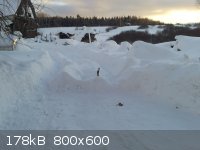
   
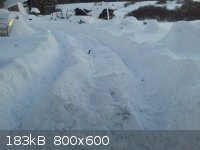
[Edited on 31-12-2013 by Hennig Brand]
"A risk-free world is a very dull world, one from which we are apt to learn little of consequence." -Geerat Vermeij
|
|
|
roXefeller
Hazard to Others
  
Posts: 463
Registered: 9-9-2013
Location: 13 Colonies
Member Is Offline
Mood: 220 221 whatever it takes
|
|
A lovely and tranquil scene. It must add to the pleasure of loud noises and the smell of smoke plumes wafting by. Is it your plan to plow that
2-track this winter with more charges?
BTW, great idea for remote ignition, I've been trying to conceive of something like that but I was only imagining pistol primers. Do you use a
sufficient length of visco to give visual indication at a distance that the firing train is lit?
[Edited on 31-12-2013 by roXefeller]
|
|
|
Hennig Brand
International Hazard
    
Posts: 1284
Registered: 7-6-2009
Member Is Offline
Mood: No Mood
|
|
Thanks, depending on atmospheric conditions there are sometimes really nice echoes over the country side following a detonation. Warm humid days, or
rainy days, in the summer seem to produce the best audible effects. Dry cold days in the winter don't produce as nice an effect. This is my perception
anyway. In the last few weeks we have had probably about 6 little storms, so it is hard to keep ahead of the snow. The visual effect of the fuse
burning down does add a lot to the whole experience, yes. I normally use 6-10 seconds of fuse probably, but I am sure the experts would say to use
much more for safety.
"A risk-free world is a very dull world, one from which we are apt to learn little of consequence." -Geerat Vermeij
|
|
|
| Pages:
1
2
3
4
..
7 |